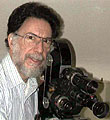|
|
This topic comprises 2 pages: 1 2
|
|
Author
|
Topic: A-chains and B-chains
|
|
|
|
|
Ken Lackner
Phenomenal Film Handler

Posts: 1907
From: Atlanta, GA, USA
Registered: Sep 2001
|
 posted 09-15-2007 03:08 PM
posted 09-15-2007 03:08 PM




The A- and B-chains are portions of the path of sound from the film all the way out to the speakers. The A-chain includes everything from the exciter, through the reader, through the preamp (in the case of an reverse scan reader), and through the preamp card in the processor. (Or, at least the preamp "section" on modern processors such as the CP650.) "Doing an A-chain" involves checking and, if necessary, aligning, all the components in this section of the system. Typically it would refer to physically adjusting the focus, azimuth, and lateral positon of the reader assembly, as well as setting the optical gain ("Dolby Level") and slit-loss EQ on the preamp card.
The B-chain is everything after the preamp, from the equalizer circuitry, through the fader, amplifiers, and out to the speakers. "Doing a B-chain" usually refers to performing house equalization and setting levels.
I am sure someone can offer a more precise explanation, but that's my $.02. I, too, have long been curious as to where these terms got their names, and I would like to know the answer to that question.
Could someone please clarify whether the NR circuitry is part of the A-chain or B-chain? I would think it's the B-chain.
| IP: Logged
|
|
|
|
John Hawkinson
Film God

Posts: 2273
From: Cambridge, MA, USA
Registered: Feb 2002
|
 posted 09-15-2007 07:12 PM
posted 09-15-2007 07:12 PM




This is really debatable, but it's also not a very interesting question (why are we asking?). Essentially the NR takes place in-between the A chain and the B chain. In the formal historical definition Louis offers, of course there was no NR.
If you forced me to pick, I would place the NR in the A chain for two reasons:
1) Pragmatically, when you do the A chain, you're paying close attention to the optimizing the NR. You are ensuring that you make Dolby Level -- that your gain is appropriate for proper NR decoding. Yes, you are not adjusting the NR circuitry, but you are watching the output of the NR circuitry (e.g. when you look at LEDs on a Cat. 222, etc.)
2) If you feed in external signals, like with a Cat. 85C pink noise generator, they feed in post-NR. Since pink noise is the basis for B chain calibration, you cannot really argue that the B chain includes circuitry that is not involved in the calibration.
For instances, a broken NR card could show in the A chain alignment, but it would not show up in the B chain alignment.
(Now, some might observe that in analog cinema processors, SR decoding has no place in the A chain alignment. While this is true, it's an artifact of some special historical optimizations Dolby made. Formally speaking, you ought to align Dolby A with Dolby Tone and align Dolby SR with Dolby Noise, and do this for every film seperately. But conveniently all films are (ostensibly) recorded at the same levels for us, with the A level and the SR level set equivalently.)
However, to play Devil's Advocate, each A chain is specific to a particular sound reproducer. If you have a changeover system, both projectors share the same NR. You do two A chain calibrations and one B chain calibration. There is only one set of NR circuitry, so it can't be part of the A. Furthermore, if you run mag, you may use the processor's NR circuitry. The mag A chain and the optical A chain are entirely seperate.
I think, again, that it is best to consider the NR to be inbetween the A chain and the B chain.
Dolby says:
quote: Dolby Model CP65 Cinema Processor Installation and Alignment Instructions
The system alignment procedure is divided into two parts—the A-chain alignment which covers the projector, optical preamplifier, and Dolby noise reduction adjustments—and the B-chain alignment which covers the portions of the system from the room equalization circuits to the CP65 fader through to the loudspeakers.
Any input from the tapeheads? I think they really set the definition of these terms...
--jhawk
| IP: Logged
|
|
Scott Norwood
Film God

Posts: 8146
From: Boston, MA. USA (1774.21 miles northeast of Dallas)
Registered: Jun 99
|
 posted 09-15-2007 07:26 PM
posted 09-15-2007 07:26 PM





So, where does the matrix card fit? A-chain or B-chain?
To my way of thinking, the A-chain would stop at the matrix card and the B-chain would start with the room EQ (optical decoding vs. room setup common to all formats (optical, digital, non-sync, video, etc.)), but I would be interested in the "official" answer.
(I should add that I'm thinking of analog processors here, but I don't see why digital processors would be any different, except that the NR and matrix may be implemented in software rather than on discrete physical cards.)
quote: John Hawkinson
In the formal historical definition Louis offers, of course there was no NR.
No Dolby NR, but the Academy filter served (serves) the same purpose.
| IP: Logged
|
|
|
|
|
|
|
|
|
|
|
|
|
|
|
|
|
|
John Hawkinson
Film God

Posts: 2273
From: Cambridge, MA, USA
Registered: Feb 2002
|
 posted 09-23-2007 04:43 PM
posted 09-23-2007 04:43 PM




Stephen asked, "Could you say that the A-chain is everything that is used only for optical film tracks, and the B-chain is everything that is also used for non-sync, digital, mag/aux etc. inputs"
No.
To restate what Gordon said:
There is an A chain for optical.
There is an A chain for mag.
You could even argue there is an A chain for digital sound alignment, though that terminology is not typically used.
I still don't understand why there's interest in trying to shoehorn so much stuff into these definitions. A chain typically refers to the optical sound setup, B chain to the EQ (and post), and if you try to fit other things into these definitions, you are likely to just confuse people you are talking to.
--jhawk
| IP: Logged
|
|
|
|
All times are Central (GMT -6:00)
|
This topic comprises 2 pages: 1 2
|
Powered by Infopop Corporation
UBB.classicTM
6.3.1.2
The Film-Tech Forums are designed for various members related to the cinema industry to express their opinions, viewpoints and testimonials on various products, services and events based upon speculation, personal knowledge and factual information through use, therefore all views represented here allow no liability upon the publishers of this web site and the owners of said views assume no liability for any ill will resulting from these postings. The posts made here are for educational as well as entertainment purposes and as such anyone viewing this portion of the website must accept these views as statements of the author of that opinion
and agrees to release the authors from any and all liability.
|

 Home
Home
 Products
Products
 Store
Store
 Forum
Forum
 Warehouse
Warehouse
 Contact Us
Contact Us




 Printer-friendly view of this topic
Printer-friendly view of this topic
















![[Confused]](confused.gif)



